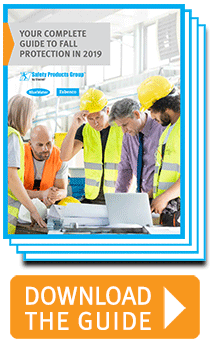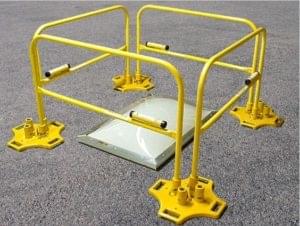Staying compliant with OSHA's regulations doesn't only help you avoid fines: it protects your workers as they perform their tasks. The only way to stay compliant and keep your workers safe at the same time is to install the correct roof fall protection systems for your needs. And because roofs can vary in structure, it's important to recognize some key differences. We'd like to take a look at how to pick the right guardrails or safety railing for your facility—and how you can protect your business and workers at the same time.
 When Guardrails are Needed
When Guardrails are NeededAs an employer or safety manager, it's important to know exactly where your responsibilities start. What's the elevation at which you need to start thinking about roof fall protection systems? Are there different elevation guidelines for guardrails depending on industry? Keep yourself and your workers covered by understanding when you need to institute fall protection. There are different height requirements for different industries, according to OSHA:
According to OSHA training guidelines, there are also some general regulations on roof fall protection systems to keep in mind:
If you already know that you need guardrails or roof fall protection systems based on your industry and elevation, your next step is to carefully consider the specifics of the roof your workers will be using. Are there skylights on the roof? Access ways? Parapets? Here's a closer look at some specifics you might encounter when researching fall protection systems for your workers:
If you want to protect your workers and your roof's membranes both at the same time, you probably want to consider a non-penetrating guardrail. Essentially, this means that your guardrail system will be installed without drilling holes or cutting through rubber membranes. These non-penetrating guardrails won't damage your roof's integrity, but they will provide the OSHA-required safety measures. They accomplish this through the use of cast iron bases.
 Skylights
SkylightsIf your workers will be working around skylights or other openings on the roof, you need to take special precautions. Workers can easily fall through glass or open skylights while busy at work, so it's important to keep these areas protected. OSHA requires that you set up guardrails, a personal fall arrest system, or a cover that can support two times the weight that may be placed on it.
While some rooftops will be accessed by staircases, others are only accessible to workers via access ways like roof hatches. Clearly, an open roof hatch represents a fall hazard and has to be protected with guardrails. All stairway floor openings need to be guarded by a safety railing, and the same goes for hatches, ladderway floor openings, and chute floor openings.
Similar to access points like hatches and ladders, any ramps or runways on your roof need to be specially protected with guardrails. According to OSHA guidelines, you need to make sure that the guardrails are erected on each unprotected edge of the ramp or runway.
Depending on the roof your workers are using, there might be parapets. Put simply, parapets are parts of the wall that extend above other parts of the wall. If they're not high enough, then you still need to install guardrails in order to meet OSHA's requirements for fall protection. A good parapet guardrail will clamp onto the parapet and use compression plates to decrease potential damage to surfaces. It's also possible to install a parapet guard rail extension that will allow your workers access to the leading edge on the roof's parapet.
Each job site and industry is going to require unique solutions to protecting workers. When it comes to finding the best roof fall protection systems for your specific site, make sure that you partner with experts who understand how to prioritize worker safety while also satisfying all OSHA requirements. At BlueWater Manufacturing, we're happy to help answer your questions, apply our expertise in your workplace, and ensure you have the best fall protection systems possible.